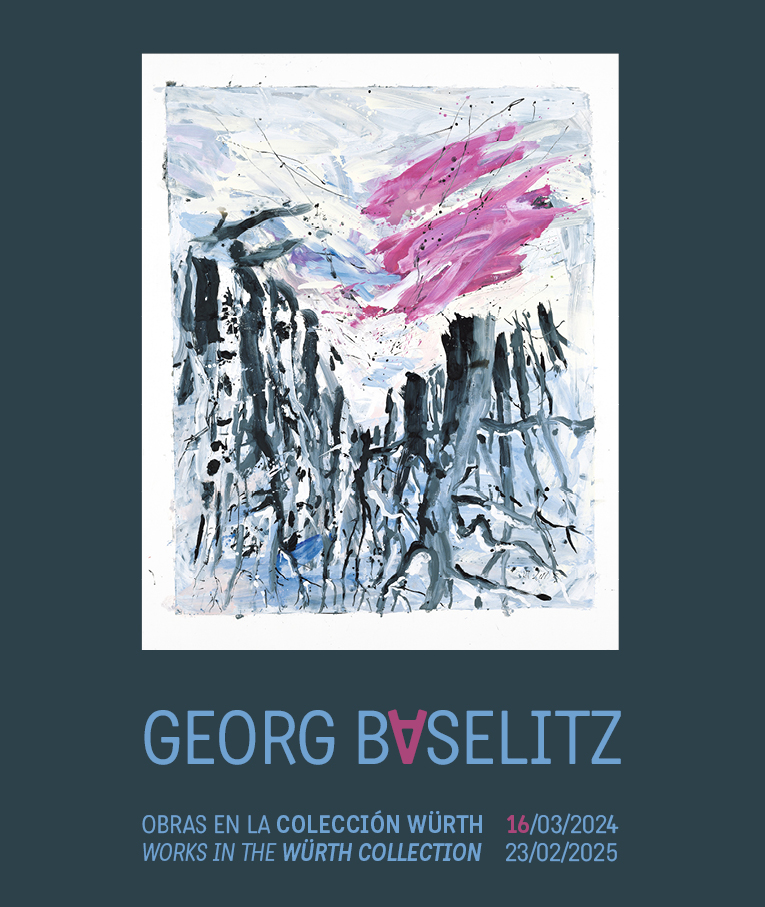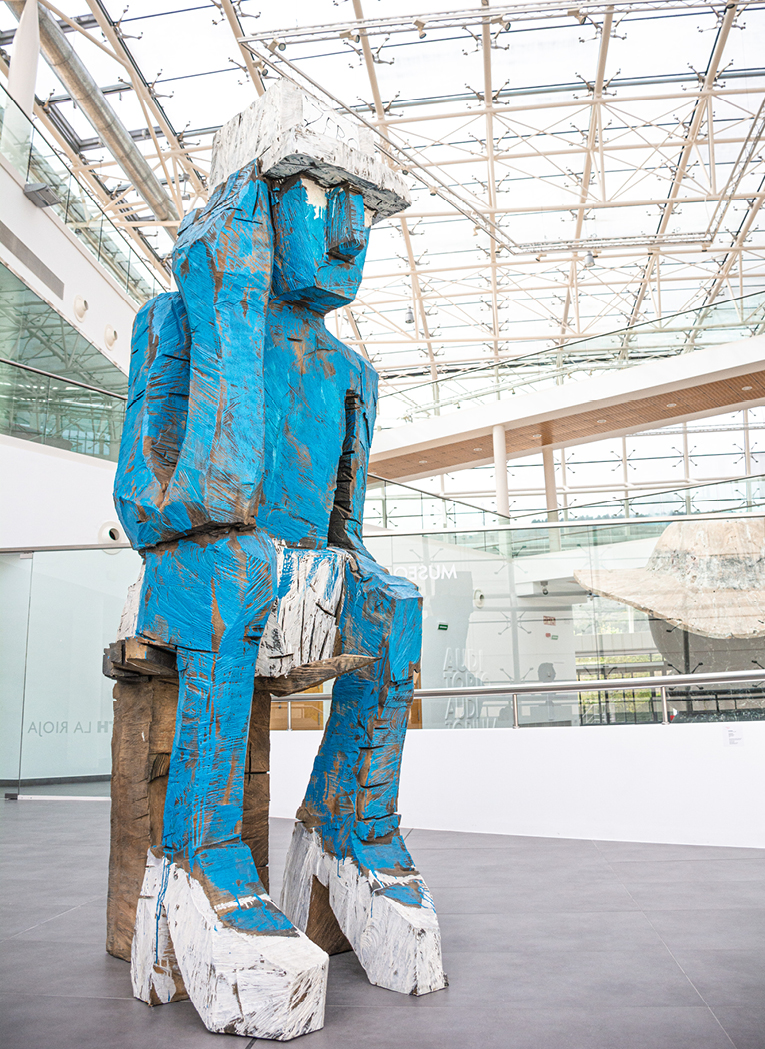|
|

Exposiciones
16/03/2024 -
23/02/2025
GEORG BASELITZ,
OBRAS EN LA COLECCIÓN WÜRTH/
WORKS IN THE WÜRTH COLLECTION
|
Inauguración, viernes 15 de marzo de 2024, 19:30h
Confirmación de asistencia: +34 941 010 410
Georg Baselitz es uno de los artistas alemanes más importantes de la segunda mitad del siglo XX y una de las figuras fundamentales del arte internacional de nuestro tiempo. Su carrera se ha construido sobre un profundo conocimiento de la historia de la pintura y sobre una asombrosa capacidad para encontrar nuevos medios artísticos con los que confrontar a los movimientos de vanguardia imperantes. Su trabajo es provocador y enérgico; irreverente en la forma, culto en las referencias, magistral en la ejecución y refinado en lo intelectual. Pero, sobre todo, es la plasmación de la pasión por la pintura como disciplina y de la reflexión, transversal en su obra, sobre el significado de la representación de la realidad en el arte.
Hans-Georg Kern nació en Deutschbaselitz, en Sajonia en 1938. Su trayectoria artística está atravesada por la historia alemana del siglo XX. Tan solo tenía 7 años cuando acabó la 2ª Guerra Mundial; su región quedó bajo dominio soviético; creció en los límites del control ideológico impuesto por el gobierno de la RDA. En 1957 ingresó en la Facultad de Bellas Artes y Artes aplicadas de Berlín Oriental, de la que fue expulsado dos semestres después por lo que llamaron “inmadurez socio - política”; se matriculó a continuación en la Facultad de Bellas Artes de Berlín Occidental, donde descubrió tanto el Arte Contemporáneo de su tiempo como la Historia del Arte Universal. En 1961 adoptó Georg Baselitz, en referencia a su localidad de nacimiento, como nombre artístico. Ese mismo año se construyó el Muro de Berlín que separó las dos Alemanias hasta que fue derribado en 1989. Su primera exposición individual, en 1963 fue considerada un escándalo, y dos de sus obras fueron confiscadas hasta 1965 por inmoralidad; la connotación de escándalo y provocación fue asociada al nombre de Baselitz hasta bien entrados los años ‘80, cuando ya se había convertido en un artista de gran reconocimiento internacional. En la actualidad es uno de los artistas esenciales para entender el desarrollo de la Historia del Arte Contemporáneo del siglo XX.
En los años ‘60 el panorama artístico internacional potenciaba los movimientos vinculados con la Abstracción, el Informalismo, el Minimalismo y el Arte Pop en Occidente, y con el Realismo Social en los países de la órbita soviética. En este contexto, Baselitz llevó a cabo una reflexión propia sobre el sentido de la pintura en la que pretendía explorar la abstracción sin renunciar a la representación figurativa. Su solución fue invertir las imágenes, no en el resultado final, sino durante el proceso pictórico, de manera que lo figurativo fuera abordado, pintado, como algo abstracto. Los formatos monumentales y la técnica del artista que pinta (aun hoy) en el suelo, aumenta el valor gestual, subjetivo y abstracto de sus obras y, sobre todo, reivindica el valor de la pintura por sí misma. Las obras invertidas son uno de los rasgos diferenciales y transversal de su obra, pero sólo una parte de una carrera de más de ’60 años. Desde los años 80, Baselitz trasladó su manera de abordar la pintura a la escultura, en un primer momento sobre madera y, con posterioridad, con fundidos en bronce intervenidos posteriormente con óleo, muchos de ellos monumentales. Con todo ello, el artista ha creado un cuerpo artístico incómodo que se enfrenta, desde su propia vida, a la Historia de Alemania y homenajea a todos sus referentes de la Historia del Arte Universal.
Georg Baselitz, obras en la Colección Würth cuenta con 41 obras que recogen escultura monumental, óleos de gran formato y grabados de distintas técnicas y épocas de su trayectoria artística. La exposición propone un recorrido desde su obra reciente a su obra antigua a través de obras escogidas de los fondos de la Colección Würth y permite comprender la figura de un creador incansable, que optó por una figuración sin concesiones, cruda y provocadora, y determinó la creación artística universal del siglo XX. |
Opening, Friday 15 March 2024, 19:30h
Attendance confirmation: +34 941 010 410
Georg Baselitz is one of the most important German artists of the second half of the 20th century and a key figure in international art today. His career has been built on a thorough knowledge of the history of painting and an astonishing ability to find new ways of artistic expression that he uses to challenge prevailing avant-garde art movements. His work is provocative and energetic, irreverent in form, cultured in its references, masterful in execution and intellectually refined. However, more than anything, it embodies a passion for the discipline of painting and reflects on the meaning of representing reality in art, a theme that constantly reappears in his work.
Hans-Georg Kern was born in Deutschbaselitz in Saxony in 1938 and his career as an artist is entwined with 20th century German history. He was just seven years old when the Second World War ended; the Soviets took control of his region, and he grew up under the ideological limitations of the GDR government. In 1957, he entered the East Berlin Faculty of Fine and Applied Arts; he was expelled after two terms for his so called “social-political immaturity”. He then enrolled in the West Berlin Faculty of Fine Arts where he discovered both the contemporary art of his time and the universal history of art. In 1961, he began to use Georg Baselitz as his artistic name in reference to his place of birth. The Berlin Wall was built this same year, and it separated the two Germanys until it was pulled down in 1989. Baselitz’s first solo exhibition in 1963 was considered scandalous and two of his works were confiscated until 1965 on grounds of immorality. His name had connotations of impropriety and provocation until well into the 1980s, by which time he was established as a great internationally renowned artist. Today, his work is key to understanding how the history of 20th century contemporary art developed.
During the 1960s, the international art scene encouraged movements that were linked to Abstraction, Informalism, Minimalism and Pop Art, in the West, and Social Realism in the Soviet states. In this context, Baselitz produced his own reflections on the meaning of painting, turning to raw and expressive realistic representation, exploring abstraction without fully abandoning figurative representation. His solution was to invert his images during the painting process, although not in the finished piece, so that figures were approached and painted as something abstract. The vast canvas size and his technique of painting on the floor (which he still does today) intensified the gestural, subjective, and abstract content of his works, and reclaimed the value of painting itself. Inverted paintings were a distinguishing feature and a running theme throughout his work but they are just one aspect of a career that has spanned more than sixty years. Since the 1980s, Baselitz transferred his approach to painting to sculpture, initially using wood and later bronze casts that were then painted in oil paint; many of these pieces are monumental in scale. Ultimately, Baselitz has created an uncomfortable body of artworks that challenge the history of Germany, by using his own life story, and pay tribute to his icons in the universal history of art.
Georg Baselitz, Works in the Würth Collection displays 41 pieces that include huge sculptures, large oil paintings, and engravings made using a variety of techniques from different periods of his artistic career. The exhibition takes viewers on a tour from his recent work to his early art through pieces that have been chosen from the Würth Collection and gives viewers an understanding of a tireless creator whose raw and provocative figurative representation made no concessions and shaped universal artistic creation in the 20th century.
|

Georg Baselitz,
Alemania, 1938
Portada
Zurück in die Schulzeit
Vuelta a la escuela, 2005
Óleo sobre lienzo
250 x 200 cm
Colección Würth, Inv. 8.578
© Georg Baselitz 2024 |
Georg Baselitz,
Germany, 1938
Cover
Zurück in die Schulzeit
Back to School, 2005
Oil on canvas
250 x 200 cm
Würth Collection, Inv. 8.578
© Georg Baselitz 2024 |
Volk Ding Zero - Folk Thing Zero
Popular cosa Cero - Folk Thing Zero, 2009
Bronce patinado y óleo, Ej. 1/3
311 x 122 x 123 cm
Colección Würth, Inv. 14.512
© Georg Baselitz 2024
|
Volk Ding Zero - Folk Thing Zero, 2009
Patinated bronze and oil, Ex. 1/3
311 x 122 x 123 cm
Würth Collection, Inv. 14.512
© Georg Baselitz 2024
|
Descargar folleto de la exposición:
GEORG BASELITZ,
OBRAS EN LA COLECCIÓN WÜRTH |
Download exhibition flyer:
GEORG BASELITZ,
WORKS IN THE WÜRTH COLLECTION |
APP MUSEO
Guía multimedia de los museos, exposiciones y jardines escultóricos de la Colección Würth.
Descarga gratuita de la APP del museo en tu móvil o tableta (disponible en castellano e inglés).
|
MUSEUM APP
Multimedia guide to the museums, exhibitions and sculpture gardens of the Würth Collection.
Free download of the museum's APP on your mobile or tablet (available in Spanish and English). |
|


